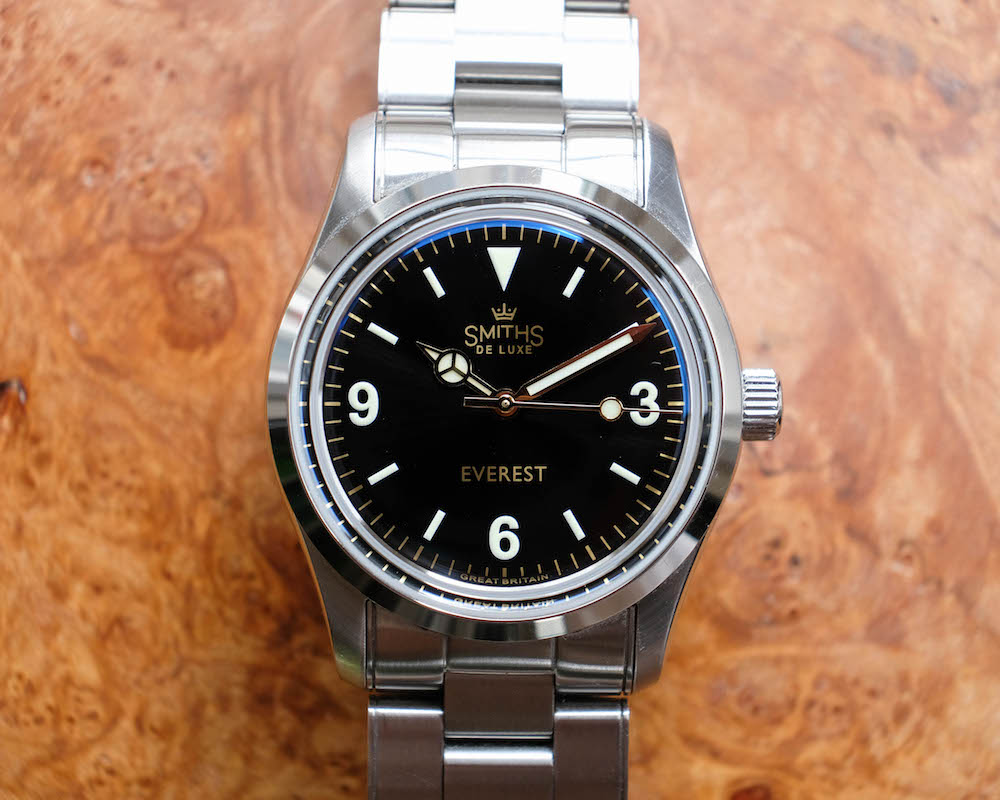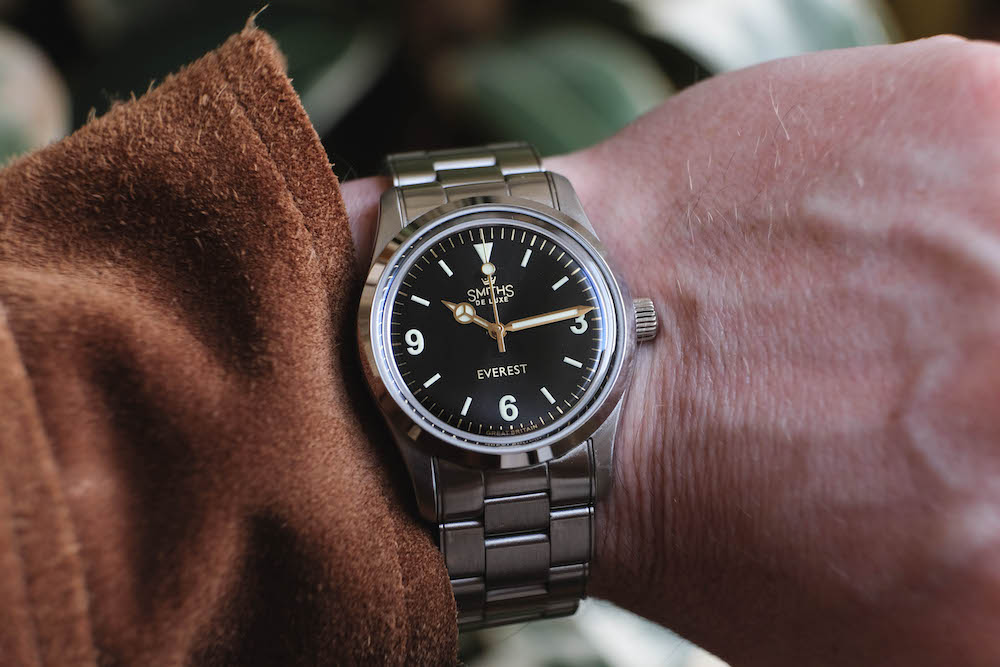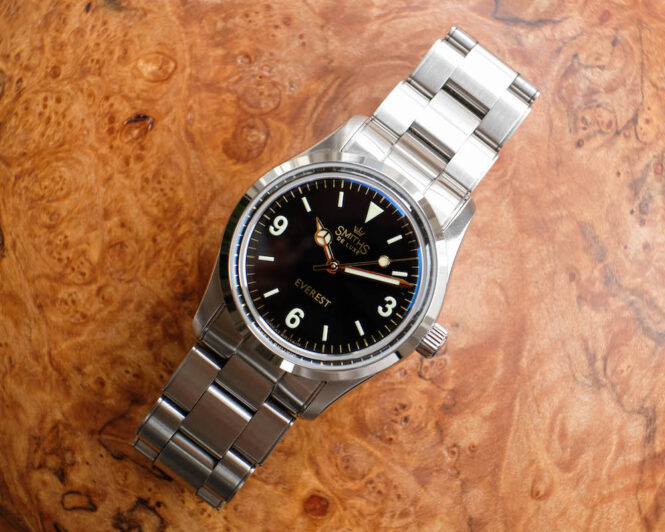I’ve made mention on numerous occasions that I dream about owning a Rolex 1016 Explorer. Unfortunately, my dream is also the dream of many others, and there simply aren’t enough of these vintage watches to go around. The silver lining is that the 1016 has become one of the most “riffed”-upon watches out there in the past few years, from small startups to knockoff-makers to high-end Swiss brands. One of the most popular of these Explorer alternatives has been the Smiths Everest, and I was able to get my hands on one a few months ago.
Behind the Brand: Smiths Watches and Timefactors
Smiths has an interesting and somewhat convoluted history. Technically speaking, the brand has been around since 1851 and was a leader in the British watchmaking industry; however, the company slowly faded into obscurity in the 1970s as Swiss manufacturing took over and competition from quartz watches challenged the industry as a whole.
In the time since then, the Smiths name has been bought by Eddie Platts of Timefactors, and he now produces watches with the defunct company’s branding. Some of the Smiths watches he sells are a nod to their past designs, and some are not – which leads to the next part of this story.
As the (somewhat debatable) legend has it, a Smiths watch was on the first successful trip to the top of Mt. Everest with Sir Edmund Hillary and Tenzig Norgay, along with a Rolex Explorer. The PRS-25 is an amalgamation of these histories, but instead of being modeled after the Smiths watch on this journey it is instead a close copy of the much more popular Rolex Explorer.

Ultimately, the Smiths/Timefactors Everest is basically an “homage” (aka copycat) watch – albeit a very well-executed one – with a bit of extra history that was purchased to go alongside it. Whether this is good or bad is up to you, but most people looking at the Smiths Everest are looking for a well-made alternative to a Rolex that is no longer produced, so a less renowned history comes with the territory.
Design & Movement
I won’t bore you all with the technical specs of the Everest, as you can read them here. In short, this 36mm watch is designed to emulate style of the Rolex 1016 as closely as possible, and overall it does a very good job of this. The case dimensions are very similar, as is the dial design. The components are less expensive of course, but that is to be expected given that it is less than 5% of the cost of a Rolex.
The Smiths Everest has gone through many iterations over time, each one being a notable improvement over the previous version (in my opinion). Here are some of the changes that TimeFactors has made to the Everest in the past few years:
- Updating dial from 40mm to 36mm
- Changing the logo style to the vintage crown version (very Rolex-esque, but true to the Smith brand’s history)
- Removing rivets from the oyster-style bracelet
- Updating the clasp to a smaller design
- Changing the movement from Miyota 9015 to 9039
- Adding a “gilt” version with golden-hued highlights
It’s clear that Eddie is listening to feedback and making changes based on what his customers want. I had been eyeing this watch for a long time, but it wasn’t until recently that I felt that the iterations made it something that I would truly want and not just a “close enough”-type product. The version I sprung for is their “gilt” version, though there are several others (like the classic and honeycomb). To me, the gilt dial gives a great balance between the vintage nostalgia of the dial and modern upgrades (like lumed indicies and solid steel bracelet links).

Overall, the design and build quality are very good (and much better than I would expect at the ~$500 price). The 140-gram weight is substantial for the size and gives an impression of solid construction. The case is well-proportioned and looks intentionally designed, as opposed to being assembled from readily-available OEM pieces.
The only part that brings the perceived quality down is the clasp; although it has been upgraded from previous iterations (where it was way too big), it still is a bit fickle and has a generally unsatisfying “squish” and some overall give, rather than a nice clean click to open and close. Additionally, it opens a bit too easily in my opinion and creates risk to pop off without warning (this has happened to me). If Timefactors can find a better clasp, this watch will be difficult to distinguish from pieces many times more expensive.

The movement is a basic Miyota automatic, known as a workhorse affordable movement that gets the job done. The change from 9015 to 9039 is effectively the same, just removing a “ghost” date position on the crown (since this watch doesn’t have a date function). If you hand-wind the watch you’ll notice that the sound and feeling is a bit on the wimpy side, but overall the watch keeps good time and the Miyota movements are known to be dependable and relatively easy to maintain (if a bit pedestrian compared to the more esteemed movements). But for the price, no complaints here.

On The Wrist
As would be expected given the similarity to the Rolex Explorer, the Everest wears well. It is comfortable and well-proportioned. It has enough weight to have some presence on the wrist without being burdensome.
I also like this watch because it’s a great “in-between” design (much like my actual Rolex). It’s a bit sporty, but without the big presence of a diver or chronograph. It’s subdued, but substantial enough to feel durable and able to take a hit if gets knocked around. 
How To Purchase Smiths Watches
An unfortunate fact about Smiths and Timefactors is that I have to write a whole section on how to buy one. If you’re unfamiliar with Timefactors you might think that purchasing a watch is as simple as going to their website and adding one to your cart. This would make a good deal of sense, but I regret to inform you that the process is nothing like that.
Eddie runs the Timefactors website in a bizarre way that I have not seen anywhere else. His web shop has certain “hours” that it will be open, and only then can you shop it. Additionally, popular models like the PRS-25 will often sell out within minutes of the store opening. Once 200 units are sold, the store “closes” again until further notice. So in order to get one, you have to know when it’s in stock, when it will be available for purchase, and then act very quickly.
Ultimately, the only way to effectively to do this is to sign up for the Timefactors emails. They’ll let you know when the store is going to be open and what will be available. If the model you’re interested in is listed, be ready to log on right when it opens – for me on the west coast, this is generally 6am on Sundays (not ideal). All told, it’s a huge pain and took me a few tries to make it work, but once I was successful the transaction and shipping went smoothly.
The alternative is to grab on one the secondary market, though prices are much higher and can commonly be double the MSRP or more. Frankly, I don’t think it’s worth it to go this route. These watches are not a collector’s item – they’re a replica of a very expensive watch, not an heirloom in and of themselves.
Advantages
- Good pricing at retail – very hard to beat at around $500 with shipping.
- Solid movement and build quality – feels and looks good, keeps good time.
- Great proportions and fit for the watch and bracelet.
- Handsome design – the 1016 is a classic and this riff on it hits all the right spots.
- My favorite alternative to the 1016, especially for the price.
Disadvantages
- Difficult to get – between the high demand and wild store hours, actually purchasing one can be quite frustrating.
- Clumsy clasp – a weak point in the design, feels lower quality than the rest.
- Winding feels weak compared to a higher-end movement.
- It’s basically a knockoff of the 1016 – though out of production and no longer available, the fact stands that it’s not an original design.
Conclusion
This watch and the complex “history” behind it bring forth a few interesting questions – how important is a story? How important is originality and authenticity? And how much do these things factor into the price of a watch? These are blurry questions without good answers, and at the end of the day this watch is an affordable copycat piece for those of us who can’t afford the real thing (and given that a good 1016 easily goes for over $20k, that’s almost all of us).
I’ll continue to hold out hope that a distant relative will leave me an untouched Rolex 1016 that was found in the back of a closet somewhere, but in the meantime I am happy with this alternative that I don’t have to worry about. It is unlikely that I’ll be using this watch while I scale frozen granite cliffs, and much more likely that I wear it while reaching for ice cream in the back of the freezer – so in that sense, it is more than enough.
